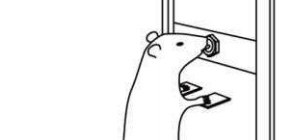
Effects of forced movements on sensory–motor associative learning confirmed in rat experiments
Will lead to application to neurorehabilitation technology
Chief researcher KANEKO Hidekazu at the National Institute of Advanced Industrial Science and Technology, together with Associate Professor HASEGAWA Yasuhisa at the Graduate School of Systems and Information Engineering, University of Tsukuba (at the time of research), and Associate Professor TAMURA Hiroshi at the Graduate School of Frontier Biosciences, Osaka University, developed an experiment model for rats in order to examine effects of an apparatus for generating forced movements and demonstrated that it was possible to intervene in the learning process by the sensation induced by forced movements.
In spite of heightened expectations for the use of the apparatus for generating forced movements for rehabilitation, the degree of disability varies by person, so it’s hard to verify its effects. In the meantime, it had been known that rats could learn correct responses to different stimuli just as humans can.
In order to examine the effects of forced movements on learning, this group created an experiment model by installing solenoid actuators on a lever activation device of a training apparatus for rats that this group had developed. Experiments on healthy rats using this experiment model showed that lever activation on the incorrect response side, but not on the correct response side, reduced the time to learn correct response.
By applying this experimental model to hemiplegic rats caused by cerebral infarction, if the neural mechanism in the process of rehabilitation using the apparatus for generating forced movements is elucidated, it will promote the sophistication of neurorehabilitation technology using neuroscientific knowledge.
Abstract
To investigate how motor sensation facilitates learning, we used a sensory–motor association task to determine whether the sensation induced by forced movements contributes to performance improvements in rats. The rats were trained to respond to a tactile stimulus (an air puff) by releasing a lever pressed by the stimulated (compatible condition) or nonstimulated (incompatible condition) forepaw. When error rates fell below 15%, the compatibility condition was changed (reversal learning). An error trial was followed by a lever activation trial in which a lever on the correct or the incorrect response side was automatically elevated at a preset time of 120, 220, 320, or 420 ms after tactile stimulation. This lever activation induced forepaw movement similar to that in a voluntary lever release response, and also induced body movement that occasionally caused elevation of the other forepaw. The effects of lever activation may have produced a sensation similar to that of voluntary lever release by the forepaw on the nonactivated lever. We found that the performance improvement rate was increased by the lever activation procedure on the incorrect response side (i.e., with the nonactivated lever on the correct response side). Furthermore, the performance improvement rate changed depending on the timing of lever activation: Facilitative effects were largest with lever activation on the incorrect response side at 320 ms after tactile stimulation, whereas hindering effects were largest for lever activation on the correct response side at 220 ms after tactile stimulation. These findings suggest that forced movements, which provide tactile and proprioceptive stimulation, affect sensory–motor associative learning in a time-dependent manner.
Figure 1
Figure 2
Figure 3
To learn more about this research, please view the full research report entitled “ Effects of forced movements on learning: Findings from a choice reaction time task in rats ” at this page of the Learning & Behavior website.
Related link
